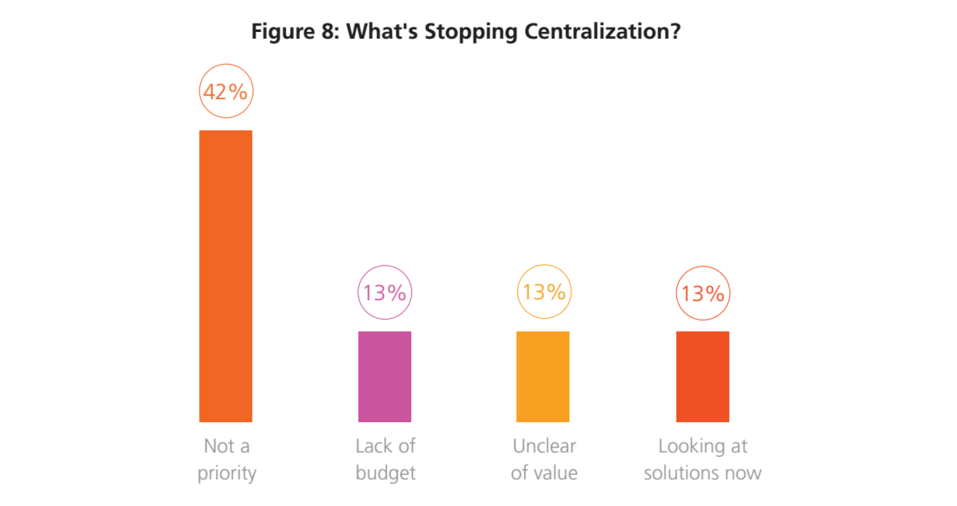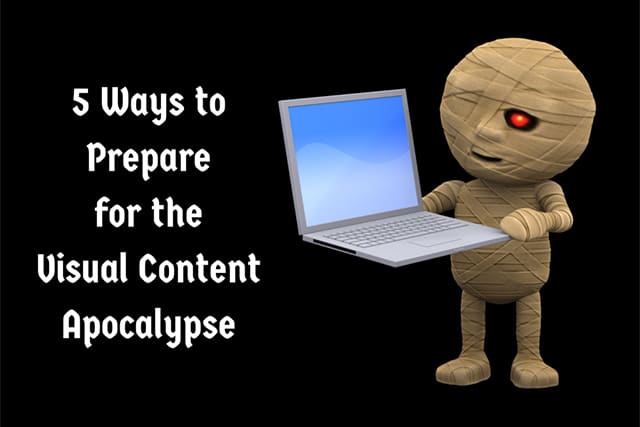This post was originally published in iMediaConnection.
I hate to be the bearer of bad news, but there’s a cataclysmic event headed right for content marketers. It’s the visual content apocalypse.
I know, I know… the last thing we need is another apocalypse.
We’re producing and publishing more content than ever before. There are very tangible business rewards that can be gained for brands gifted in the art and science of connecting content with audience and converting audience to customers. And along with this, there’s a very real euphoria for the marketer that comes with the success of producing content that hits its mark.
So, we continue to feed the beast. We produce and publish more, and more, and more. We see how the audience reacts to photos (really well), so we feed the beast more photos. Then we learn how they react to text laid atop those photos, and we feed the beast crafty memes. Then infographics. Then video clips — the beast certainly loves these. So we feed it more.
Recently, PhotoShelter for Brands team fielded a study with the CMO Council where we learned how top marketing executives are approaching visual content strategy. Not so surprisingly, respondents say we’re going to see video (79 percent), infographics (60 percent), and photo (50 percent) continue to rise in importance in the future.

With the power to quickly make or procure content, then quickly help that content find its perfect audience, the opportunity feels boundless. Yet, when life feels this good — when the job feels this easy — it’s important to ask the tough questions.
I’m not suggesting there’s a great content bubble that’s about to pop. In fact, visual content will only continue to grow as the top medium for how we communicate. However, it’s become very apparent that in the race to feed the beast more visual content, we’re overlooking some critical issues that will continue to pile up. We’re well on our way to creating a mess for ourselves (like tossing the clutter into the closet before the guests arrive). If we don’t address these issues now, it will spell trouble later. Do we really need a visual content apocalypse?
Here are five suggestions for what your company can do to avoid an impending disaster.
Hire a chief visual officer
Given the dramatic increase in significance of visual assets, someone in your company operating at a high level must be responsible for translating your brand strategy into a comprehensive visual strategy. I first read about the idea via Paul Melcher’s Kaptur. As I talk to large organizations about optimizing their visual asset strategy, the need for a CVO — and the pain points a role like this might address — continues to frequently arise.
Think of all the many different channels you’re producing content for today — likely you’re experimenting across Facebook, Twitter, Instagram, Pinterest, Snapchat, Periscope, and so on. The CVO will tie it all together and dictate the strategy for how visuals will be used to enable successful audience engagement. This means finding someone with a strong photography background capable of determining the most powerful way to tell your story visually. However, the necessary skills extend far beyond producing photo shoots, editing, and selecting imagery or videos. A CVO should be mapping out the full ecosystem where you need to be communicating, how you’ll source those visual assets most appropriate for each channel, how you’ll deploy them on a channel-by-channel basis, and how you’ll generate the maximum return on your content investment over the long term.
Centralize visual content planning
From our recent survey with the CMO Council, we learned that very few companies have evolved toward a centralized content planning approach. In fact, more than 60 percent said they leave content planning to individual teams to handle independently within their smaller organizational silos. Digital media teams plan their content acquisition and usage independently and with little connection to advertising and PR or physical channels like in-store, partners, and sales teams. When content planning occurs in silos, the customer experience becomes fractured and inconsistent. Plus, severe organizational inefficiencies arise. Undoubtedly, multiple scattered investments are made in the acquisition and production of unique visual content to feed the beast, without regard for how these investments can be maximized across teams.
It’s not too hard to fix this problem (especially if you hire a CVO with responsibility to do so). Once you’ve decided on the holistic customer experience, you can establish content development processes that bring these channel owners together to plan and agree on visually engaging experiences relevant to each channel, and the content that’s needed company-wide to make the strongest possible impact.
Get savvy about your content sources
Savvy means making smarter determinations on where to go to get the content that will best tell your story. Your primary choices include your crowd, stock photo and video agencies, commissioned shoots, and even hiring staff. Don’t underestimate the difference that sourcing will make in your visual campaigns. For example, are you aiming for high production value or gritty authenticity? Do you want the audience to “see themselves” and literally participate in the story which lends itself to crowdsourced content, or do you want to engage the audience in a more aspirational vision (i.e., using models and great lighting, often the purview of lifestyle photography professionals). Do you want a consistent style and feel to every campaign touchpoint? If so, you’ll likely find yourself commissioning a shoot and building a library of approved content rather than sourcing from an agency or your crowd.
Getting savvy about sourcing also means it’s time to worry more about usage rights and permissions, and proper compensation of creators. Just as brands like Whole Foods and Chipotle seem to take a greater interest in the producers — the folks actually making the raw product that helps the company succeed — it’s time to take good care of the content producers too. For example, if you’re crowdsourcing content via social media, are you truly acquiring the rights to use these photos in advertising just because people used a suggested hashtag? (Ask your legal department.) Are you using agencies that pay artists fairly for their content (if not, check out Pond5). And if you’re producing the content internally, it’s time to recognize the power and importance of this end product and budget appropriately to hire or commission professionals. Progressive new brands, like Derek Jeter’s venture The Player’s Tribune, seem to have expertly mastered this mix of employing social content and hiring professionals to produce owned content.
Get serious about visual asset accessibility
So, we’ve already established the overwhelming importance of using visual assets to communicate, and how we all plan to make more visual content as time moves on. However, a surprisingly significant number of respondents to our survey — over 40 percent of marketing executives — admitted that central management of the assets has not been a priority. Essentially, top marketers say that making more content is a top priority and that content strategy occurs haphazardly across teams, yet centralizing the management of this content is barely on the radar. Right about now some serious alarm bells should be going off (perhaps in the CFO’s office, especially).

Let’s start with the obvious marketing implications. Your team needs access to visual content in order to operate nimbly, especially the folks handling social media, who must be empowered to act/react in real time as opportunities arise. So, if you’re serious about enabling your team to do their content-related jobs as best as possible, you need to get equally serious about having a system (or library) of approved content that’s well-tagged for searchability and accessible to those who need it. This is where status quo solutions like shared drives, your designer’s desktop, your third-party agency, and even Dropbox fall down in comparison to a centrally administered, cloud-based, searchable content library with robust access control permissions.
There are serious financial implications to consider as well. Letting content sit scattered across an organization — especially in an environment where content planning is relegated to silos — invites massive duplication in effort. If I can’t find a photo or video I need for this month’s campaign, I may waste precious hours ferreting through the organization to find it. Or perhaps worse, I’ll turn outward to pay to have it produced independently (again). This stuff happens all the time. It’s totally avoidable if you acquire the right visual asset management tools, create processes to centralize the content, and help your team find it.
Know where the bodies are buried
The beauty in the way content spreads online, across channels, and is then distributed by evangelists is that you have millions of new opportunities to engage new audiences. Yet, as content ages and becomes outdated, the way it has spread so nicely can also present some dangers to your brand. Take, for example, that mobile app launch video from 2012, or the photo of your CEO with Donald Trump. Designs and styles change, as does public opinion, and sometimes you need to roll back some of your content or replace it with updated work. So knowing precisely where your visual content resides is a huge help. This starts with understanding who has accessed content and how it’s been used in campaigns. This can’t happen if you simply have your content stored on individual hard drives or the company shared network.
The visual content apocalypse is coming, and those organizations who don’t prepare now are going to find it hard to catch up as the pile of content assets continues to grow. Taking steps to better strategize and centralize planning, sourcing, and management of visual content will undoubtedly show benefits in both audience engagement and maximizing content investments.



